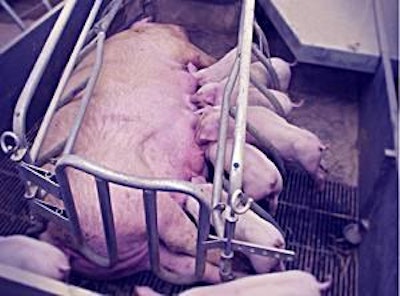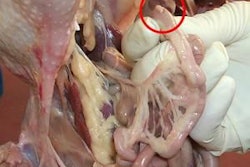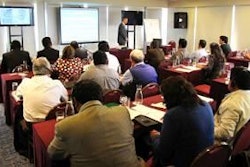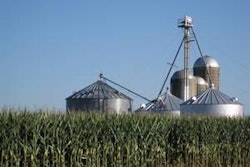
Here in Denmark we believe that the new piglet production target of 35 weaned pigs per sow annually is within reach. The financial crisis that has hit most Danish pig producers hard is making them focus intensively on improving efficiency and economical output. The top 5% of herds are already producing 32-34 weaned pigs per sow/year. They believe that it is possible to be even more efficient and achieve the new goal.
It is amazing to think that that target only 15 years ago was just 25 pigs per sow per year. But that was before a decision in the middle of the 1990s to add litter size to the breeding goals set nationally for Danish pig genetics.
The first addition took account of the total number of pigs born per litter. Later on, the key point became the number of pigs that were alive at Day 5 after farrowing.
Things have moved fast since then. See in Figure 1 the national development in liveborn piglets since litter size was first included in traits for selection. It is clear that the efforts have paid off. Today, the average for the 25% best producers in Denmark has moved up to 29.9 piglets weaned per sow annually.
Focus on live pigs
In the beginning the aim was to have more pigs in total per litter. However, increasing the number of piglets born offers no guarantee that they will all survive. Pig numbers still alive five days after birth provides a more practical measurement that indicates both the sow’s maternal capacity and the strength of the piglets.
A higher litter size has had many side-effects on the housing and management of the farrowing unit. Originally, the most common farrowing pen dimensions were 1.5m x 2.6m, around a crate with an internal length of 1.9 metres and a creep area providing 0.55-0.60m2 of space for the piglets.
Over the last 20 years, however, sow length has increased by 10% and sow weight has risen by 20%. At the same time the average size of litter has grown from 10 pigs to 14 pigs. All this has made it necessary to work with bigger pens.
The latest designs are larger for pen, crate and creep area, so they provide more space for nursing, resting and the movement for sow and piglets.
The export of Danish genetics to many other countries means that similar considerations also apply to herds even if they are located quite far from Denmark. Whatever the location, it is important to make sure that the design of the pens and of the production units suits the size and performance of these animals in order to obtain the highest output. Our own experience with designing pig units and management of Danish genetics in Russia, Belarus and Serbia shows that, when all parameters are optimised, an annual total of 30-31 weaned piglets per sow might be reached in these countries as well.
Saving piglets
Look internationally and it seems that the increasing litter size has also led to more piglets being dead at birth or stillborn. Having 2.0-2.5 stillborn piglets per litter is quite common in Danish herds. But we have noticed from our work with East European producers using Danish genetics that they often have only 0.5-0.7 pigs stillborn in each litter on average. This would be similar to the level of stillbirths seen 15 years ago.
The explanation for the difference may be in the fact that many East European countries are required by law to have staff present in the farrowing unit 24 hours per day. Therefore, more piglets are saved that would otherwise have died and been designated as “stillborn” if no personnel had been surveying the farrowings.
This knowledge inspired us to develop a new electronic tool which might assist the staff in other countries to survey farrowings more effectively. We expect that a closer monitoring of each farrowing sow can save at least 0.5 pigs per litter. This corresponds to a value of more than Euro 30 (US$44) per sow per year.
Cross-fostering techniques have been studied intensively during the last decade by Danish pig advisers. Since the sow might take care of no more than 13-14 piglets because of teat numbers, surplus pigs need to be fostered onto other sows.
This fostering usually is done in two steps. First, piglets that have received colostrum are moved to a sow (foster sow) that has farrowed a week earlier. Secondly, the piglets of the foster sow are then moved to a sow that farrowed three weeks earlier and whose own pigs are now weaned.
Foster sows take up space and farrowing capacity. In addition, moving and mixing piglets implies an infection risk. Therefore, the target is to let the sow nurse as many piglets as possible and move piglets as little as possible.
Managing super sows
Modern super genetics might be compared with race cars. Thus, a Porsche will not run very well on average-octane gasoline. Similarly, the sow and piglets will not perform well unless they are managed correctly.
A sow giving birth to 14-16 piglets and producing 14-15 litres of milk daily must be fed the right diet. Moreover, the latest Danish studies indicate that the diet should be distributed in 4-6 daily rations, which allows the sow to eat more feed. This means feed intakes of up to 10-12 kg per day.
Increasing the number of rations from the traditional 2-3/day to 4-6/day (or more) encourages the sow to stand up more often. This results in a decrease in shoulder injuries, due to the fact that she does not lie on her side for long periods of time. In other words, more feedings imply more exercise, which is important for sow performance.
Availability of water is another factor which is frequently overlooked. Lack of water limits milk production immediately. Water nipples with too little flow of water are therefore detrimental for milk production. A flow of at least 10 litres of water per minute is necessary for a high milk output. So a high-performing sow has a water intake of up to 40 litres per day when her milk production is at its highest, three weeks after birth.
Attention to such details is likely to be the single most important contributor to achieving more pigs weaned per sow/year. Of course, the extra pigs must be strong and healthy so they will make a profit. But we believe it is achievable that the sows of the future can each produce 35 of these profitable pigs annually.

















